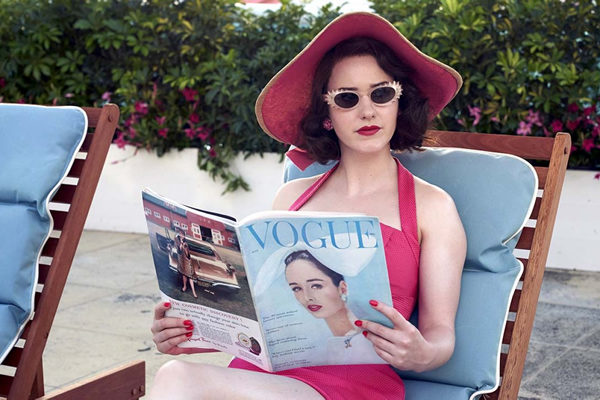
My newest crush is a gorgeous rose petal pink sun hat!
Recently, I first eyed the object of my affections. It was worn by Miriam “Midge” Maisel as she lounges by the pool in Miami. Do I need to say that the hat perfectly matches her bathing suit and beach shoes?
Aficionados, rejoice! On Dec. 6, “The Marvelous Mrs. Maisel” season three began streaming on Amazon Prime. The show was just nominated for a Golden Globe for Best TV Series, Musical or Comedy. At times, this show featuring a jilted New York City, mid-century housewife turned stand-up comic is vexing. Its world is so privileged!
Still, I find myself as addicted to “Mrs. Maisel” as a movie addict is to popcorn. Why am I stuck on this show? Because it combines the style of “Mad Men” (Sinatra! Gorgeous costumes!) with jazz, Lenny Bruce and proto-feminism.
If you haven’t entered the Maiselverse: Miriam, a.k.a. Midge, Maisel is a 1950s housewife. She’s living a comfortable life in Manhattan with her husband Joel and their children. Joel flops when he tries his hand at stand-up comedy. But, despite this, everything’s fine.
Until, that is, Joel cheats on her. Most of us in Midge’s shoes would get drunk with our buds. Not Midge.
She goes to a Greenwich Village comedy club. She’s never done stand-up before. But that’s no problem for her. Leaping to the stage, telling jokes about Joel, going topless, getting arrested – Midge becomes Mrs. Maisel, the new comic sensation. In 1958, a woman doing comedy about her own life was almost unheard of – revolutionary!
Susie (Alex Borstein), impressed by Midge’s talent, becomes her manager. Along the way, Joel becomes less of a jerk and a more loving ex. Midge breaks off her engagement with her boyfriend Ben when she gets an opportunity to go on tour opening for the popular African-American singer Shy Baldwin (Leroy McClain).
In its current season, Midge and Susie go on tour with Shy – going from Las Vegas to Miami to Harlem. They’re moving from 1959 into the early 1960s. It’s “the 60s, man!” Things are changing! We’re in the JFK era! Lenny Bruce and Mrs. Maisel talk about “smoking weed” on a TV late night show. Midge refuses to do an ad for the (then) emerging anti-feminist, anti-queer, right-winger Phyllis Schlafly. (Passing up some needed bucks to do this.)
Yet, as always with “Mrs. Maisel,” many things haven’t changed. The sexism and racism shown in the show are still with us – even if in more subtle forms. Men are given a chance to make mistakes, Mrs. Maisel says in one of her comedy sets. “Why isn’t a woman allowed to fail,” she asks.
“I can’t stay here!” Shy says to Midge when she says she’ll get something for him from his room in “their hotel” in Miami. “This is the South!”
Though we never see Susie with another queer women or at a gay bar, this show is queer in its DNA. There’s Jane Lynch as the imperious Sophie, who Susie’s been suckered into managing. Wynda Sykes appears as the great “Moms” Mabley. Midge remains friends with Shy after he tells her he’s gay. (Given the era, Shy has to be in the closet.)
Still, I can’t help wishing to see more of Susie’s queerness and back story. Given the time the show’s set in, I don’t expect her to be out to anyone – even Midge (with whom she’s formed a Thelma and Louise types woromance.) Yet, couldn’t we see Susie having a beer in a dyke bar?
Out of the blue, Susie tells Midge that she has a law degree. Nothing more is said about it. Like Midge, I wondered: What?
Despite those caveats, as I’ve said in the Blade before, “Mrs. Maisel” inspires us to resist injustice. For fuel for resistance and mid-century glitz and glam, check out “The Marvelous Mrs. Maisel.”
Kathi Wolfe, a writer and a poet, is a regular contributor to the Blade.
